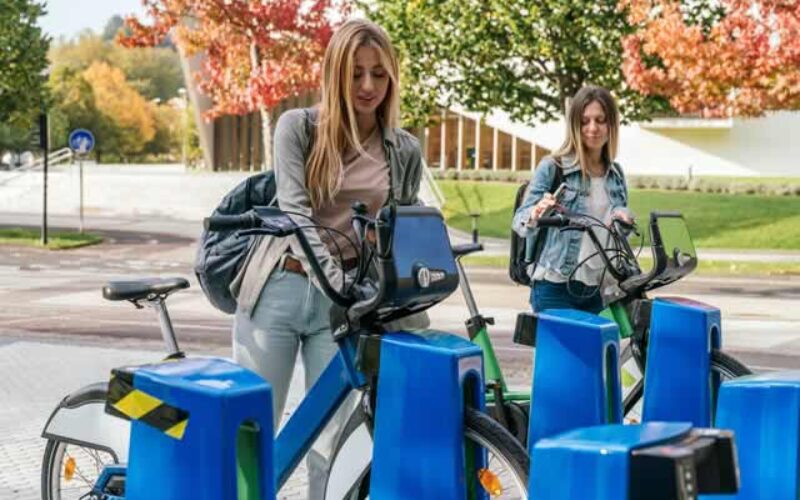With their affordability, accessibility, and ease of use, these programs are transforming the way students engage with their campuses and surrounding communities.
This guide will walk you through the ins and outs of campus bike share programs, explaining how they work, their benefits, and tips for making the most of them. Whether you’re new to cycling or just want to maximize your campus commuting options, you’ll find everything you need to know right here.
Introduction to Campus Bike Share Programs
Campus bike share programs are designed to provide students with a practical, eco-friendly transportation option. These programs typically involve a network of bikes strategically placed across campus, allowing students to rent bikes for as short or as long as they need.
Stations may be located near dormitories, academic buildings, dining halls, and even local businesses, making it convenient to grab a bike on the go.
Most programs are app-based, enabling users to locate, unlock, and pay for bikes directly from their smartphones. Some universities even include free or discounted memberships for students, making it easier than ever to integrate biking into daily life.
These programs not only prioritize convenience but also promote sustainability, helping universities reduce their carbon footprints.
Benefits of Using Campus Bike Share Programs
Campus bike share programs offer a variety of advantages that cater specifically to college students. From saving money to staying active, these benefits go far beyond just getting from Point A to Point B.
-
Cost-Effectiveness
One of the standout features of bike share programs is their affordability. For students on a budget, these programs present a low-cost alternative to taxis, ride-shares, or maintaining a car.
Many universities partner with bike share providers to offer discounted rates or free trials exclusively for students, ensuring that everyone has access to this practical resource without breaking the bank.
-
Health and Fitness
Between lectures, study sessions, and exams, it can be tough to prioritize exercise. Campus bike share programs provide a built-in opportunity to incorporate physical activity into your routine.
Even a 10-minute bike ride between classes can help boost your cardiovascular health, improve mental clarity, and reduce stress. Plus, starting your day with an energizing bike ride can set a positive tone for the hours ahead.
-
Environmental Impact
For students passionate about sustainability, bike share programs are a tangible way to contribute to a greener future. Biking instead of driving significantly reduces greenhouse gas emissions and helps combat campus congestion.
By choosing bikes over fossil-fuel-powered transportation, you’re actively supporting your university’s efforts to create a more eco-friendly campus.
-
Convenience and Accessibility
Forget waiting for the campus shuttle or rushing to find a parking spot. With bikes readily available across campus, you can get where you need to go on your own schedule.
These programs often feature docking stations at key locations, ensuring bikes are accessible whether you’re heading to class, grabbing a coffee, or exploring off-campus.
How to Use Campus Bike Share Programs
To take full advantage of campus bike share programs, it’s important to understand how they work. While specific processes may vary between universities, the general steps involve registration, locating a bike, and returning it safely.
-
Registration Process
Before you can start using a bike share program, you’ll need to create an account. This is typically done through an app or university portal, where you’ll provide some basic information and payment details. If your school offers discounts or free memberships, be sure to use your student ID to claim these benefits.
-
Finding and Unlocking a Bike
Once registered, use the app to locate available bikes near you. Most systems provide real-time maps showing the locations of docking stations and bike availability. After finding a nearby bike, you can unlock it by scanning a QR code or entering a code provided in the app.
-
Riding and Returning the Bike
Enjoy your ride and take advantage of the ability to pause rides if you need to make a quick stop. When you’re finished, return the bike to any docking station within the designated program area. Ensure it locks securely to avoid additional fees.
-
Safety Tips and Guidelines
Familiarize yourself with local cycling rules before hitting the road. Wear a helmet, use hand signals to communicate with drivers, and stick to bike lanes whenever possible. Prioritizing safety ensures a smooth experience for both you and those around you.
Tips for Making the Most of Campus Bike Share Programs
Campus bike share programs aren’t just for getting to and from class. With a bit of planning, you can maximize their full potential and add variety to your daily routine.
-
Planning Your Route
Before heading out, take a moment to map your route. Many apps highlight bike-friendly paths and shortcuts, helping you reach your destination efficiently. Knowing your route ahead of time can also save you from navigating busy streets or unexpected detours.
-
Using Bike Share for Commuting
Bike share programs are ideal for short, regular commutes—for example, traveling between dorms and lecture halls or heading to the gym. Incorporating biking into your daily schedule can help you avoid relying on limited shuttle schedules or crowded parking lots.
-
Exploring the Community
Beyond campus, many bike share programs extend their service areas to surrounding neighborhoods. Use this opportunity to explore off-campus cafes, parks, and cultural attractions. It’s a great way to get to know your town while enjoying the fresh air and a change of scenery.
-
Participating in Group Rides and Events
Check if your university hosts group rides, bike-themed events, or sustainability initiatives. These activities promote community building and provide a fun way to connect with fellow students who share your interests.
Safety and Etiquette
Staying safe and respecting others are essential parts of using any bike share program. By following a few simple guidelines, you can ensure an enjoyable experience for yourself and everyone else.
-
Wearing a Helmet
Although most programs don’t provide helmets, investing in one is a smart choice. A well-fitted helmet can significantly reduce the risk of injury in case of an accident.
-
Following Traffic Laws
Cycling is subject to many of the same rules as driving. Obey traffic signals, yield to pedestrians, and avoid riding on sidewalks unless explicitly permitted.
-
Being Mindful of Pedestrians
On campuses where walking paths are shared, always ride at a safe speed and announce your presence when passing pedestrians. Courteous behaviors create a safer environment for everyone.
-
Reporting Issues and Accidents
If you encounter a damaged bike or are involved in an accident, report it promptly through the program’s app or customer service. This ensures proper maintenance and accountability for the program’s continued success.
other related articles of interest:
Why Bike Share is the Key to a Better Campus Experience
Campus bike share programs offer more than just a practical way to get around; they enhance your overall college experience. From cutting costs and staying active to reducing your carbon footprint, the benefits are undeniable.
By making biking a part of your routine, you’ll discover new parts of your campus and community, all while contributing to a more sustainable future.
If you’re ready to ride into a new chapter of campus life, explore your school’s bike share program today. You might just find that two wheels are all you need to unlock a world of possibilities.
Image Credit: campus bike share programs by envato.com
end of post … please share it!
PAYING FOR COLLEGE: getting the aid you need
-------------------------------------------------------------------------------------------------------------
end of post idea
-------------------------------------------------------------------------------------------------------------
view home improvement ideas at our Photo Remodeling center












